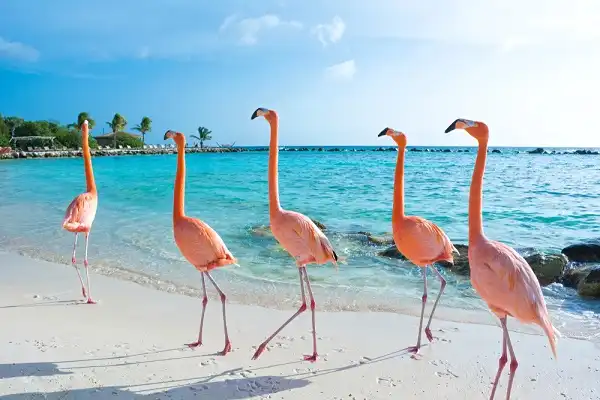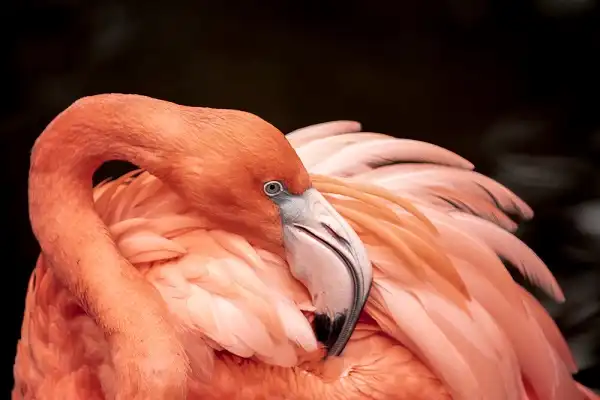Flamingos are one of the most recognizable birds in the world, but there is still much that many people don’t know about these fascinating creatures. For instance, did you know that flamingos are usually born with gray feathers? Keep reading to learn more interesting facts about flamingos.

Flamingo Description
Flamingos are beautiful birds, known for their long legs, curved neck, and vibrant pink plumage. Their beak is specially designed with comb-like structures along the edges that act as filters to capture tiny aquatic animals like crustaceans and mollusks. Flamingos are wading birds, meaning they rely on shallow water to feed them. They have webbed feet that help them balance while standing in water or mudflats. Flamingos often congregate in large groups so they can find food more efficiently, particularly when conditions are difficult or scarce. Flamingos are also known for their distinct courtship dances which involve marching around each other in circles, head bobbing, stretching out their necks and wings, making loud honking noises with their beaks, and displaying colorful plumage. These elaborate displays help attract potential mates or signal dominance among rivals.
Flamingo Habitat
Flamingos are most commonly found in warm climates near shallow lakes, lagoons, mangrove swamps, or estuaries. These environments provide an abundance of food sources such as plankton and small crustaceans for flamingos to feed on and thrive. The birds also consume plants like grasses and leaves for sustenance. Flamingos require these areas because they are typically unable to fly more than a few hundred feet at a time due to their high body weight. These habitats also offer protection from predators; the birds can wade relatively safely in shallow water with their long necks and legs while remaining visible should a predator approach them. Additionally, some species of flamingos have been known to use their wings as shields from wind and rain and roost in large colonies which helps provide greater security from potential predators. Beyond providing the necessary resources to sustain them, these wetland habitats offer another important benefit to flamingos: they provide them with ample opportunities to interact socially with other members of their species. This interaction provides important psychological benefits that help promote healthy behavior within the flock and foster strong social bonds between individuals.
Flamingo Diet
Flamingos are known to have a wide variety of diets, as they feed on multiple kinds of food sources depending on the availability and season. They primarily consume plankton and aquatic creatures such as mollusks, crustaceans, and insects. Additionally, plants such as algae, grasses, and leaves are also on their menu. Flamingos have an interesting way of foraging for their food; they use their long necks and curved beaks to filter the water in search of small aquatic prey. Their beaks are equipped with special lamellae which can sift through the water quickly and efficiently. The birds can also upend themselves while in the water to help them look through the mud below more easily. This behavior is commonly seen amongst flamingo flocks in shallow waters near estuaries, lagoons, or mangrove swamps where they typically reside. Interestingly enough, the flamingo diet also varies depending on their age. Chicks are fed by regurgitating a liquid mixture called “crop milk” from their parents’ crops that is rich in proteins and fats which help them grow rapidly. As adults, however, flamingos rely primarily on plankton for sustenance due to its high nutritional value.

Flamingo Size
Flamingos come in a wide range of sizes, ranging from just over 3 feet tall in the case of the smallest species, the lesser flamingo, to around 5 feet tall in the tallest species of flamingo, the greater flamingo. On average, an adult flamingo will typically weigh between 3 and 6 pounds depending on its species and gender. This can vary significantly, however; some individuals have been observed to reach nearly 10 pounds in weight. The length of a flamingo’s bill is also highly variable; it can range from around 4 inches for smaller birds to over 8 inches for larger ones. The bills are curved uniquely in a way that allows them to filter tiny organisms from the water quickly and efficiently. It also serves as an important tool for self-defense by acting as a shield to ward off potential predators. In terms of coloration, flamingos are unique amongst other bird species due to their vibrant pink or orange feathers. Interestingly enough, this comes from their diet; they feed primarily on crustaceans which contain carotenoid pigments that accumulate in their feathers giving them their iconic coloring. Additionally, some species also have black markings on their wings which can be used as visual cues during courtship rituals or flock interactions.
Flamingo Lifespan
Flamingos typically have a lifespan of between 15 and 30 years in the wild, with up to 40 years reported in captivity. While this may seem short compared to other species of birds, their long legs allow them to live longer by enabling them to forage for food more efficiently and reducing the risk of predation. The longevity of flamingos also depends on the availability of resources; an abundance of food sources can help keep them healthy and prolong their lives while limited resources can reduce their ability to store fat or find enough nutrients to stay nourished. Additionally, since they tend to travel in large flocks they can become vulnerable if they are not able to find enough food; this often leads to weakened individuals that don’t survive as long as those living in healthier habitats. Flamingos are also extremely resilient creatures that are able to withstand extreme weather conditions. They can survive temperatures close to 0°C (32°F) provided they have access to a warm shelter during winter, and some species even migrate over thousands of kilometers each year in search of better feeding grounds. This mobility helps maximize their chances of survival over time despite the threats posed by predators or environmental changes.
Flamingo Behavior
Flamingos are social creatures and tend to form large flocks, sometimes numbering in the thousands. This behavior is believed to be an evolutionary advantage since it provides protection from predators as well as an efficient means of foraging for food. Flamingos communicate with each other through a variety of sounds and visual cues such as head movements, bill clapping, wing displays, and posturing. These behaviors are used mostly during courtship and mating rituals as well as during disputes over food or territory. In addition to foraging for food flamingos also engage in play behavior such as chasing one another in the water or even providing mutual preening services where one bird uses its bill to clean parts of another’s wings or feathers. This type of behavior helps keep them socially connected while also strengthening bonds between members of the flock which can be particularly helpful during breeding season when male-female pairs must demonstrate their loyalty and commitment to one another in order to successfully raise chicks together.

Flamingo Speed
Flamingos have impressive speed capabilities when it comes to both land and air travel. When on the ground, they are able to reach speeds of up to 20 miles per hour, which is impressive considering their large size and long legs. In the air, they can reach much higher speeds of up to 50 miles per hour while migrating between different areas. Flamingos are also able to take off quickly from water sources, with some reports suggesting that they can leap into flight in just two seconds! However, flamingos may not always use their maximum speed for longer periods of time. They are considered a migratory species that typically moves between areas in flocks; when doing so, the birds tend to fly at a more leisurely pace that conserves energy and maintains harmony amongst the flock members.
This slower pace has been documented as being somewhere around 30 miles per hour. In addition to running and flying, flamingos also have another mode of transportation available – swimming! They are able to swim quite quickly in both shallow and deep waters thanks in part to their webbed feet which provide extra propulsion power as well as their oiled feathers which help keep them buoyant. Studies show that flamingos can swim at an average speed of around 5 miles per hour but reports suggest that this could increase under certain conditions such as when chased by predators or when trying to keep up with fast-moving flocks during migrations.
Flamingo Hunting
Flamingos are a popular bird amongst hunters due to their impressive agility and speed; this makes them incredibly difficult to capture. They typically fly in flocks or large groups which further increases the difficulty of hunting as it requires accuracy and precision when attempting to take down a single target. Additionally, they are known to be quite alert and can sense potential danger from far away, giving them an even greater advantage over hunters as they will often flee before any shots can be taken. Given the challenge of hunting flamingos, some hunters have resorted to using technology such as drones or radio-tracking devices in order to locate the birds before taking aim with guns or bows. This has become increasingly popular amongst hunters who are looking for an easier way to bag one of these beautiful creatures. Unfortunately, this method is not without its own set of risks as some areas may require special permits or licenses in order for you to be able to make use of tracking devices or drones while hunting. In addition to traditional hunting methods, there are also several other ways that you could pursue flamingos including trapping them with nets or baited lines. While this approach is much less intrusive than shooting, it is important that you do your research beforehand and check with local authorities regarding any restrictions they may have in place on trapping birds such as flamingos.

Conclusion
Flamingos are incredible birds that are capable of impressive feats such as running and flying at high speeds. They can also swim quite well and possess heightened alertness which aids them in evading danger. However, there is always the possibility of simply watching flamingos from afar without causing any harm to the species; something which is becoming increasingly popular amongst bird watchers. No matter if you hunt them, observe them, or just appreciate their beauty from afar, one thing is certain – flamingos have certainly earned their place in the animal kingdom!
Frequently Asked Question

